Sourcing for a large project? Choosing the wrong wattage can cause inconsistent lighting and budget overruns. I'll show you how to get it right every time.
To choose the right wattage for COB LED downlights, focus on lumens per watt, not just wattage. For large projects, consider the application, ceiling height, and desired brightness level (lux) to ensure uniform, efficient lighting. This approach guarantees performance and avoids costly mistakes.
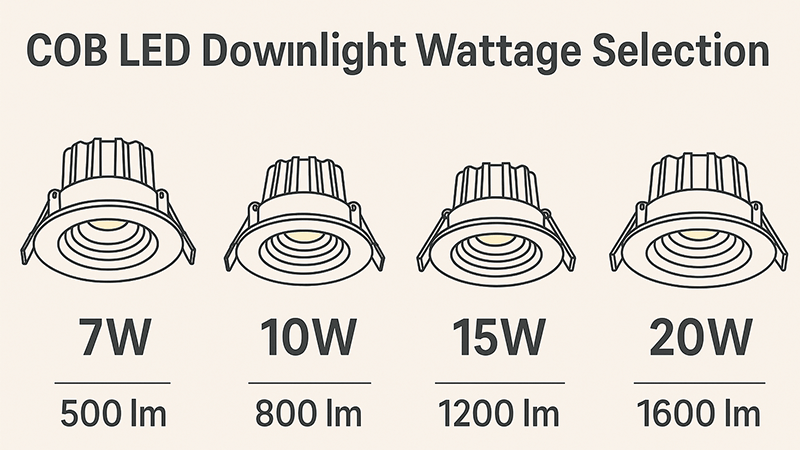
Choosing the right wattage feels complex, but it's simpler than you think. It's not just about a single number; it's about understanding what that number means for your project's success. Let's break down the key factors so you can make confident decisions for every space you illuminate.
What wattage is best for LED downlights?
Confused by all the wattage options? Picking the wrong one leads to spaces that are too dim or harshly bright. Let's find the perfect balance for your needs.
The best wattage depends on the application. For general ambient lighting1 in residential spaces, 8-12W is common. For commercial settings2 like offices or retail, you might need 15-30W or more, depending on ceiling height and required brightness3 levels.
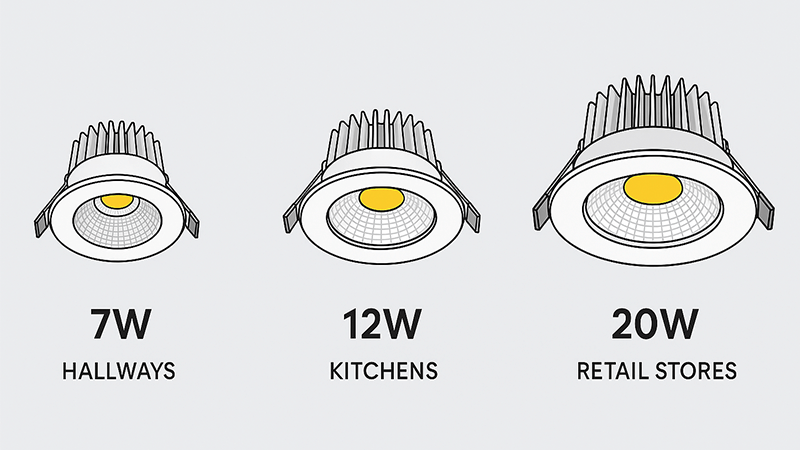
There is no single "best" wattage for all LED downlights because the ideal choice changes with every project. The right question isn't about the wattage itself, but what you need the light to do. It’s about matching the light output to the space's function and dimensions.
Matching Wattage to Application
The first step is to consider where the lights will be installed. A downlight for a hotel room is very different from one for a shopping mall atrium. For a purchasing manager like Shaz, specifying the right wattage for each area is critical to meeting the project's requirements.
I remember working with a client in Dubai on a lux4ury hotel lobby. They had 6-meter high ceilings and initially wanted 15W downlights because that's what they used in the guest rooms. I explained that for that height, we'd need at least 25W-30W lights to achieve the desired bright and welcoming feel on the floor. We ran a quick DIALux simulation5 to show them the difference. They were amazed. This simple change prevented a huge mistake and ensured the final installation was perfect.
Here is a simple table to guide your initial choices:
| Application Area | Typical Ceiling Height | Recommended Wattage Range |
|---|---|---|
| Residential Living | 2.4 - 3 meters | 8W - 12W |
| Office Spaces | 2.7 - 3.5 meters | 15W - 25W |
| Retail Stores | 3 - 4 meters | 20W - 35W |
| Hotel Lobbies/Atriums | 4 meters + | 30W - 50W+ |
Always think about lumens—the actual measure of brightness—not just watts. A high-quality 20W downlight can be brighter than a poor-quality 25W one. Always check the lumens per watt6 (lm/W) to understand the fixture's true efficiency.
How to choose LED wattage?
Staring at a spec sheet can be overwhelming. Is higher wattage always better? This simple guide will help you choose the correct LED wattage for any space with confidence.
To choose LED wattage, first determine the required lumens for your space based on its size and purpose. Then, select a fixture with a high lumens-per-watt (lm/W) efficiency rating to meet that lumen target with the lowest possible wattage, saving energy and cost.
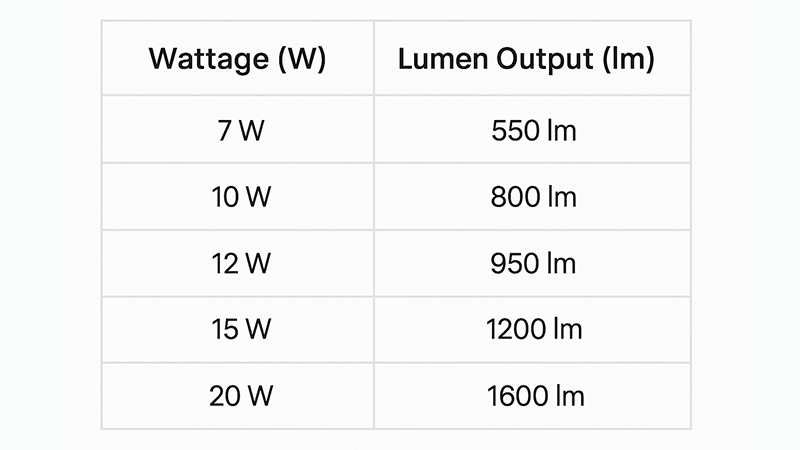
Choosing the right wattage is a two-step process. First, you figure out how much light you need. Second, you find the most efficient product to deliver that light. This protects your client's budget both on the initial purchase and on long-term energy bills.
Step 1: Determine Required Lumens
Before you even think about watts, you must know your target lumen output. Lumens tell you how bright a light is. The amount of lumens you need depends on the size of the area and what it's used for. For example, an office needs more light than a hallway. You can calculate this using a simple formula:
Total Lumens Needed = Room Area (sq. meters) x Recommended Lux Level
Lux is a measure of how much light falls on a surface. Different tasks require different lux levels.
Step 2: Focus on Luminous Efficacy
Once you know the total lumens needed, you can look for the right fixture. This is where efficiency, or luminous efficacy7 (lm/W), becomes critical. A downlight with high efficacy gives you more light for every watt of energy it consumes.
Let's say you need 20,000 lumens for a retail space.
- Option A: A downlight with 80 lm/W. You would need 250 watts in total (20,000 lumens / 80 lm/W).
- Option B: A downlight with 120 lm/W. You would only need 167 watts in total (20,000 lumens / 120 lm/W).
Choosing Option B saves nearly 35% in energy consumption8 for the same amount of light. For a large project with hundreds or thousands of lights, these savings are massive. I always advise my clients to look at the lm/W value first. It’s a clear indicator of the product's quality and long-term value.
How to calculate total fixture wattage for LED lighting?
Planning a big project and need to figure out the total electrical load? Calculating total fixture wattage9 seems complicated, but it's essential for a safe and successful installation.
To calculate the total fixture wattage, first determine the number of fixtures needed to achieve the desired brightness (lux level). Then, multiply the number of fixtures by the wattage of each individual fixture. This gives you the total electrical load for your lighting plan.
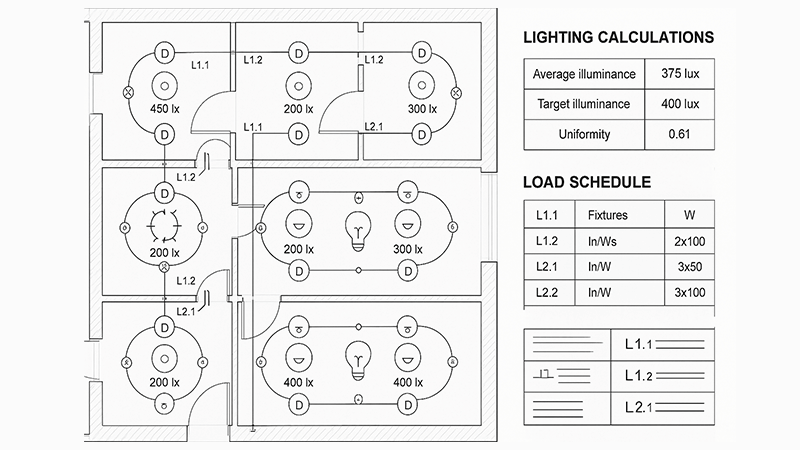
Calculating the total wattage is a crucial step for any project manager or engineer. It ensures the electrical circuits can handle the load and helps forecast energy costs. The calculation itself is straightforward, but it relies on getting the steps before it right.
From Design to Calculation
The process starts with a lighting design10, which is often done using software like DIALux. The design tells you exactly how many fixtures you need and where to place them to get the right amount of light everywhere.
Here’s a breakdown of the calculation process:
- Define Lighting Requirements: Determine the necessary lux level for the space. An office might need 500 lux, while a warehouse might only need 150 lux.
- Choose Your Fixture: Select a COB downlight based on its lumen output and efficiency (lm/W). Let's say you choose a 25W downlight that produces 3000 lumens.
- Determine the Number of Fixtures: Using lighting design software or a manual calculation, find out how many of these 25W fixtures are needed. For example, a 100-square-meter office needing 500 lux would require a total of 50,000 lumens. If one fixture provides 3000 lumens, you'd need about 17 fixtures (50,000 / 3000).
- Calculate Total Wattage: Now, just multiply the number of fixtures by the wattage of each one.
- Total Wattage = Number of Fixtures × Wattage per Fixture
- Total Wattage = 17 fixtures × 25W = 425W
The Hidden Factor: The Driver
Here's something many people forget. The total power consumption of a fixture includes the LED and the driver. A good quality driver is about 85-95% efficient. This means a 25W LED might actually consume around 28W in total. For large projects, this small difference adds up. Always confirm if the stated wattage is for the LED only or for the entire fixture.
More importantly, for COB fixtures, you must use a constant current driver11. I learned this the hard way on an early project. We used the wrong type of driver, and the brightness across the fixtures was inconsistent. Some were too bright, others were dim. It was a nightmare to fix. A constant current driver ensures every COB LED gets the exact same amount of electrical current, guaranteeing uniform brightness and a long lifespan. It's a non-negotiable detail for quality lighting.
How many watts of light per square meter?
You need to light a space, but where do you start? Estimating watts per square meter12 can feel like guesswork. Let's replace that guess with a clear, reliable method.
There is no fixed rule for watts per square meter. Instead, focus on the required lux level for the task. For example, a general office might need 4-6 watts/m², while a high-end retail display could require 10-15 watts/m² with efficient LED lighting.
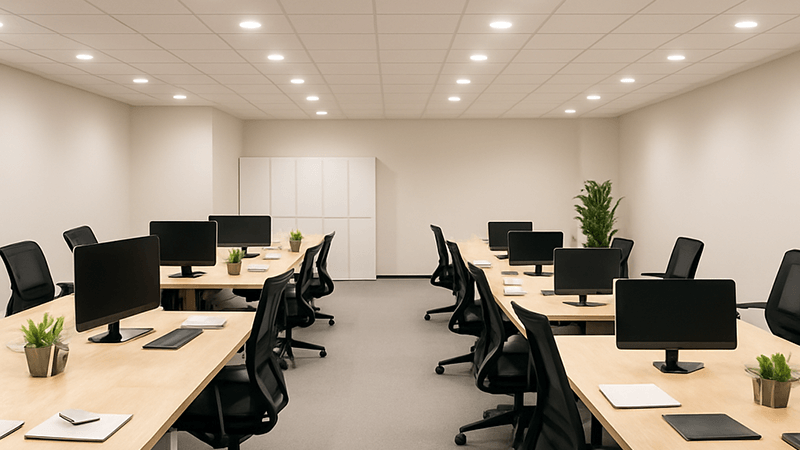
The old way of thinking was to use a simple "watts per square meter" rule of thumb. With the huge differences in LED efficiency, this method is now outdated and unreliable. A high-efficiency fixture can light a room with half the wattage of a low-efficiency one. So, we need a better approach that is based on the desired outcome, not just the power input.
A Modern Framework: Lux and Efficacy
The professional way to plan lighting is to start with the end goal: the brightness on the surface where people will be working or walking. This is measured in lux. Once you know the target lux, you can calculate the wattage needed based on the efficiency of your chosen lights.
Here is a guide to common lux levels, which you can use to calculate your lighting needs:
| Space Type | Recommended Lux (lx) | Estimated Watts/m² (with efficient LEDs) |
|---|---|---|
| Hallways/Corridors | 100 - 150 lux | 1 - 2 W/m² |
| Warehouses | 150 - 200 lux | 2 - 3 W/m² |
| General Office | 300 - 500 lux | 4 - 6 W/m² |
| Retail Stores | 500 - 750 lux | 6 - 9 W/m² |
| Detailed Task Work | 750 - 1000 lux | 9 - 12 W/m² |
Let's use an example of a 200-square-meter retail store.
- Target Lux: The goal is a bright, inviting space, so let's aim for 750 lux.
- Total Lumens Needed: 200 m² × 750 lux = 150,000 lumens.
- Choose an Efficient Fixture: I'd recommend a COB downlight with an efficiency of at least 110 lm/W.
- Calculate Total Wattage: 150,000 lumens / 110 lm/W = 1364 watts.
- Calculate Watts per Square Meter: 1364 W / 200 m² = 6.82 W/m².
As you can see, the final "watts per square meter" is an outcome of the calculation, not the starting point. This method ensures you get the exact amount of light you need while maximizing energy efficiency. It's the only way to guarantee performance for large-scale projects and deliver real value to your clients.
Conclusion
Choosing the right wattage for COB downlights is about lumens, application, and efficiency. Focus on these factors, not just watts, to ensure every project is perfectly and cost-effectively lit.
Learn how to select wattage for ambient lighting to create inviting spaces. ↩
Explore wattage recommendations for commercial settings to ensure adequate illumination. ↩
Achieving the right brightness enhances comfort and functionality in any space. ↩
Learn about lux to effectively plan lighting for different environments and tasks. ↩
DIALux simulation helps visualize lighting plans, ensuring accuracy and effectiveness. ↩
Understanding lumens per watt helps you choose efficient lighting, saving energy and costs. ↩
Discover how luminous efficacy impacts energy efficiency and lighting quality. ↩
Understanding energy consumption helps manage costs and improve efficiency in projects. ↩
Calculating total wattage is crucial for safe and efficient lighting installations. ↩
Explore expert tips on lighting design to enhance aesthetics and functionality. ↩
Learn about constant current drivers to ensure consistent brightness and longevity of LEDs. ↩
Understanding watts per square meter helps in planning effective lighting for spaces. ↩

